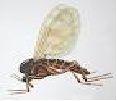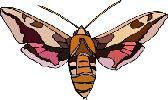Natural Solutions to Things That Bug You (61 page)
Read Natural Solutions to Things That Bug You Online
Authors: Myles Bader

FLOAT THE KILLER
If you float rings of Bti, which is a special strain of Bt it will kill only the mosquito larvae in your pond or small lake. The crotches of trees that extend into the water are especially a problem area in which Bti will do the job. Soap spray is very effective as well and changes the surface tension of the water.
BURNING GRASS?
If you place some lemon grass in a safe metal container and burn it, it will repel mosquitoes. If mosquitoes are frequenting a plant and you don’t want them, just rub some lemon grass on the leaves.
OIL THE WATER
If you spray any aerosol oil on any standing water you must have on your property it will kill the mosquito larvae and pupae by suffocating them.

BARBECUE THEM
Next time you barbecue and want to keep the mosquitoes away, just throw some sage or rosemary on the hot coals. Both of these herbs work great on the barbecue and will keep all flying insects away.
ITALIANS RARELY GET BITTEN
People, who consume garlic on a regular basis, rarely get bitten by a mosquito. Mosquitoes hate garlic flavoring in your blood.
One of the best biological control of mosquitoes utilizes garlic oil emulsion. The active ingredient
allyl sulfide
is a known mosquito killer.

CHAPTER 12

MISCELLANEOUS FLYING INSECTS
GNATS
Identification:

The adult gnat is about 1/8
inch long and is a grayish to black, with long legs and one pair of wings. The larvae or maggot is legless, white with a black head and about ¼ inch long. The larvae, is transparent and food in the gut can be observed through the body wall.
General Information:
 Gnats, also called, fungus gnats or no-seeums are small, black, flying insects, similar to mosquitoes but much smaller. They don't buzz, and they don't bite humans, they're just an annoyance. Gnats often show up at the most inappropriate times, usually when you have company over for dinner and they will hover around your face and head. Gnats are drawn to light, so you may notice them first in bright rooms, near a window or on a mirror.
Gnats, also called, fungus gnats or no-seeums are small, black, flying insects, similar to mosquitoes but much smaller. They don't buzz, and they don't bite humans, they're just an annoyance. Gnats often show up at the most inappropriate times, usually when you have company over for dinner and they will hover around your face and head. Gnats are drawn to light, so you may notice them first in bright rooms, near a window or on a mirror.
Gnats love fungus, and fungus loves moisture! Fungus and moisture can come from: Overripe peaches, bananas or tomatoes that have been sitting on your counter for a couple of days, softening potatoes stored under the cabinet for a few months or over-watered indoor potted plants.
Getting rid of the gnats is not that easy since gnats have a total life span of about four months and a female can produce as many as 300 eggs, in small batches, in fermenting or decaying organic matter. This means that if you notice that you have a gnat problem but don't know where it's coming from, several dozen females can each lay a few hundred eggs in the time.
HIDE THE PRODUCE
Keep fruits and vegetables in the refrigerator or throw them away if you aren't going to eat them and they're "past their prime." Don't over-water your plants since not all plants need to be watered weekly (or even monthly). Drain excess water from your plant containers a few minutes after you do water them. Poor drainage leads to plant rot, and both the moisture and the rot attract gnats.
Indoor gnats, which are also known as fungus gnats, are not only annoying. Their larvae feed on plant stems and roots and can cause considerable damage to seedlings and small plants. Luckily, you can get rid of these obnoxious little pests without using harsh chemicals.
Tips for preventing an Infestation
Select healthy, bug-free plants for your home. Avoid the problem in the first place by keeping them away from your home.
Isolate new plants from your existing houseplants and keep an eye out for signs of insects and diseases. If you don't notice any problems after two weeks you're in the clear to move the new plants to their permanent locations. This is a super easy way to prevent spreading problems to your healthy plants.
Fungus gnats thrive in warm, moist environments. Allowing the soil to dry between watering kills gnat larvae and makes your plant less hospitable to adult gnats looking for a place to lay eggs.
Natural Solutions
If your plant does develop a fungus gnat problem, the first thing you should do is isolate the affected plant so the problem does not spread to healthy plants.
You can then trap and drown adult gnats by placing apple cider vinegar or wine in a small bowl near the problem plant.
Remove 1/4 inch of topsoil and replace with sand. Fungus gnats prefer moist soil with a lot of organic matter and will avoid plants top dressed with sand.
If you can't get the gnat population under control you will need to repot the plant in sterile potting soil. Gently remove as much of the original soil from around the roots and trim out any diseased or rotting roots prior to repotting in fresh soil.
BAIT & TRAP
Gnats are easy to trap and eliminate from your home using a vinegar and water trap. Just fill a small jar about ¾ full of water and add 1 tablespoon of apple cider vinegar. Place the jar on your kitchen counter near a ripening fruit or even better an overripe fruit. The gnats will investigate the jar and will be killed. To control the gnat larvae in the soil use a natural organic product called Neem™. Neem™ can be purchased in any garden shop.
MOTHS
General Information:
 Never use mothballs in your closets: or even have them around the house, they are very poisonous and many pets have died from eating them and they have made hundreds of children very sick.
Never use mothballs in your closets: or even have them around the house, they are very poisonous and many pets have died from eating them and they have made hundreds of children very sick.
The adult moths are not the guilty ones when it comes to eating your clothes and leaving holes, however, it is their larvae; that actually do the damage. The female moth lays her eggs on fabric and if the fabric is moved will easily dislodge them. The larvae, uses any stains that contain food, urine or sweat to get their vitamins.